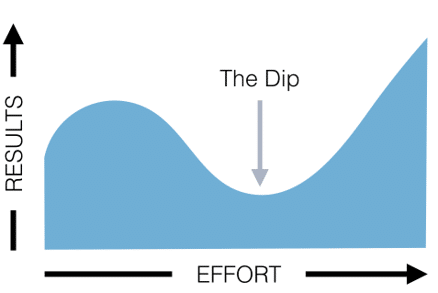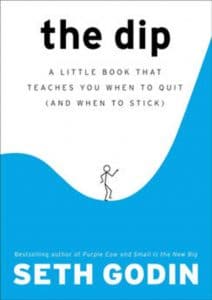Scream really loud if you’ve heard this quote: “Winners never quit, and quitters never win.” If that doesn’t get you screeching, how about this one: “Once you learn to quit, it becomes a habit.” Both are quotes by Vince Lombardi. So why do I bring up some old football coach who passed away in 1970? These quotes embody an idea that has been burned into our brains over the years, it riddles the classrooms we’ve grown up in, and it flows out of the mouths of our grandparents as they impart wisdom and knowledge.
It’s this perception that to quit is to fail. I know I have subscribed to this notion. I’m sure many of you reading this have as well. I’ve heard this from my teachers, parents, and friends: work harder, never give up, persevere no matter what. This approach was drilled into my psyche, and if this sounds familiar, let me ask you this:
How come people less motivated than you, win? How do people less talented than you get ahead?
Don’t worry, I’ll wait as you retrieve the pieces of your brain that just exploded.

What are they doing differently than you? How can you take your passion and drive, and leverage it to your advantage?
What if I told you, you need to learn to quit (and know when to stick) in order to be successful?
“Winners quit all the time. The trick is learning to quit the right stuff at the right time.” -Seth Godin
Remarkable benefit follows those who are able to strip away non-essentials, have the balls (or the ovaries) to quit early, and re-focus efforts on things that actually make a difference in order to push you closer to your goals. The secret to making progress towards where you want to be in life, lies in the ability to strategically and methodically quit the roads that lead to nowhere, and stick to the road that takes you, well, somewhere!
Seth Godin does a wonderful job giving you the tools to know when to quit and change paths, and when to stick to something that is worthwhile. I’m going to go over his visual representation of what he calls, “The Dip!”

This curve represents every endeavor you’ve ever tried, every journey you’ve ever taken, every educational pursuit you’ve ever embarked on, every goal you’ve ever worked towards; they all exist on this little X-Y axis connected by a little wavy line.
Leonardo and “the dip”
Leonardo is in his 40’s, he has a less than ideal commute to and from work, has a family he cares deeply about, is left handed, and enjoys long relaxing bubble baths–a pretty normal working family dude if you ask me. Leonardo has let his health slip over the years, has an extra layer of fluff that has caused him to increase a clothing size, and has some aches and pains he never had before when playing with his kids. He is at a point in his life where something needs to change, so he decides to join a gym and start taking his health seriously! I love it!
Enter the first curve, that first little hump. In the beginning things are fun, full of novelty, motivation is high–Leonardo is all in. He’s learning new skills, how to adopt better habits, has the support of his family and friends, and he sticks with it. All is good! Then, THE DIP HITS.
This is the long haul that lies between starting and mastery. In the case of our friend Leo, it acts as a screen to keep him from reaching his goals. The novelty has worn off, the fun has started to die out, his fat loss has plateaued. Here’s the kicker: there will ALWAYS be a dip. Everybody struggles. If Leo thinks he’s special, he’s wrong. The Dip is the secret to success. So long as it is in fact worthwhile, invest the energy and time to make it through the dip.
Don’t abandon the journey early—get yourself to the next level.
(but by all means quit if it isn’t worth it)
Up for another story?
Here’s another little story to help you understand the importance of the Dip and why you must not quit.
Why are there so few people at the top?
You can fill in the blank here with ANY sport you connect with (and if not, then maybe a profession or hobby, really anything works): I’m going to use the example of professional rock climbing. First off, it’s freaking cool, so why are there so few pro’s? Learning the skills requires immense amount of time, effort, and training can be painful. The dip is full of torn up fingers, falls, expensive gym memberships, chalk clouds and maybe death!
However, there are 3 choices to make here:
- the BOLD thing to do is to tough it out and get to the top (literally and figuratively). Become the best at what you do and obtain all benefits of sticking with it, and making it through the dip.
- the MATURE thing to do is not start because of the learning curve involved and the looooong dip before you reach success. If you know you’re not going to give it your all, if you know the dip is too strenuous, then do the smart thing and don’t bother starting. Give your resources towards anther dip that matters to you.
- the FOOLISH thing to do is to start and invest all of that time, energy, effort, and money to become the best and then quit halfway through the dip.
This applies to you—YOU have these 2 choices to make:
- Not many people do the BOLD thing and stick with it, endure the dip, and end on the other side at the top.
- Educated people will do the MATURE thing and save the resources for another passion project, because they don’t see the dip as worth it, and they do the smart thing and quit before starting.
Both of these choices are fine,
But the common choice—the foolish one—will crush you; to invest and then quit halfway through.
To quit halfway through is the worst decision you can make.
Getting Through The Dip
To get through the dip you need your reason—your purpose. It’s your driving force behind your daily actions. It’s why you are here. You’ve invested this time and effort, you’ve learned new skills, and you’ve put in money, so can you really afford to start a dip that isn’t worth it to you? You need to attach meaning to the dip otherwise you will never make it through.
“A woodpecker can tap 20 times on 1,000 trees and get nowhere OR he can tap 20,000 times on 1 tree and get dinner!”
Find your one tree, your one true purpose and plunge yourself into the process. Lean into the Dip. Accept the challenge and do the day to day things you need to make it through.
Those who throw everything they have into the dip—put forth all their effort into a singular purpose—make it through to the other side.
You grew up believing quitting equals failure. I’m here to tell you… it depends!
Realize the stuff you don’t give a s**t about and QUIT so you can free up your time and energy to give to a dip that matters to you.
Now, don’t take this as the green light to go and quit everything—to be a serial quitter or a serial starter. Rather, find a meaningful dip and give it all you have and quit the projects that don’t support your end goal.
There are two strategies that will help you in your journey through the dip.
- Ask yourself, “Do I have the resources necessary to make it through the journey?” The great thing about this is you can—to an extent—anticipate and plan for this! What will you need? Who can you call upon to help? Do you have the money or the time?
- Your motivation is in the vision you’ve created for yourself. This involves looking ahead and having the foresight to identify the house at the end of the road. Where do you want to end up? You must constantly remind yourself of the person you will have become once you make it through. This could be as simple as a Post-it note on your mirror that is constantly reminding you of where you see yourself down the road.
The ultimate question you need to ask yourself is:
IS THE STRUGGLE OF THE JOURNEY WORTH THE VALUE OF THE HOUSE AT THE END OF THE ROAD?
It’s OK to quit,
you need to quit if you’re stuck on a road that leads to a dead end. You should quit the dip if it isn’t worth the goodies! Quit the projects that lead you nowhere and stick out the projects that lead you where you need to be.
You deserve better than average!
So go forth and learn to quit the right things and stick to the things that matter.
Source:

